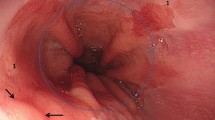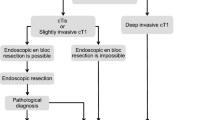Abstract
Objectives
Ulcerative colitis (UC) is associated with an increased risk of colorectal cancer (CRC). Few studies have looked at long-term outcomes of endoscopically visible adenomatous lesions removed by endoscopic resection in these patients. We aimed to assess the risk of developing CRC in UC patients with adenomatous lesions that develop within the segment of colitis compared to the remainder of an ulcerative colitis cohort.
Methods
We identified patients with a confirmed histological diagnosis of UC from 1991 to 2004 and noted outcomes till June 2011. The Kaplan–Meier method was used to estimate cumulative probability of subsequent CRC. Factors associated with risk of CRC were assessed in a Cox proportional hazards model.
Results
Twenty-nine of 301 patients with UC had adenomatous lesions noted within the segment of colitis. The crude incidence rate of developing colon cancer in patients with UC was 2.45 (95 % CI 1.06–4.83) per 1000 PYD and in those with UC and polypoid adenomas within the extent of inflammation was 11.07 (95 % CI 3.59–25.83) per 1000 PYD. Adjusted hazards ratio of developing CRC on follow-up in UC patients with polypoid dysplastic adenomatous lesions within the extent of inflammation was 4.0 (95 % CI 1.3–12.4).
Conclusions
The risk of developing CRC is significantly higher in UC patients with polypoid adenomatous lesions, within the extent of inflammation, despite endoscopic resection. Patients and physicians should take the increased risk into consideration during follow-up of these patients.


Similar content being viewed by others
References
Eaden JA, Abrams KR, Mayberry JF. The risk of colorectal cancer in ulcerative colitis: a meta-analysis. Gut. 2001;48:526–535.
Blackstone MO, Riddell RH, Rogers BH, Levin B. Dysplasia-associated lesion or mass (DALM) detected by colonoscopy in long-standing ulcerative colitis: an indication for colectomy. Gastroenterology. 1981;80:366–374.
Bernstein CN, Shanahan F, Weinstein WM. Are we telling patients the truth about surveillance colonoscopy in ulcerative colitis? Lancet. 1994;343:71–74.
Butt JH, Konishi F, Morson BC, Lennard-Jones JE, Ritchie JK. Macroscopic lesions in dysplasia and carcinoma complicating ulcerative colitis. Dig Dis Sci. 1983;28:18–26.
Lennard-Jones JE, Melville DM, Morson BC, Ritchie JK, Williams CB. Precancer and cancer in extensive ulcerative colitis: findings among 401 patients over 22 years. Gut. 1990;31:800–806.
Rosenstock E, Farmer RG, Petras R, Sivak MV Jr, Rankin GB, Sullivan BH. Surveillance for colonic carcinoma in ulcerative colitis. Gastroenterology. 1985;89:1342–1346.
Rubio CA, Johansson C, Slezak P, Ohman U, Hammarberg C. Villous dysplasia. An ominous histologic sign in colitic patients. Dis Colon Rectum. 1984;27:283–287.
Odze RD. Adenomas and adenoma-like DALMs in chronic ulcerative colitis: a clinical, pathological, and molecular review. Am J Gastroenterol. 1999;94:1746–1750.
Torres C, Antonioli D, Odze RD. Polypoid dysplasia and adenomas in inflammatory bowel disease: a clinical, pathologic, and follow-up study of 89 polyps from 59 patients. Am J Surg Pathol. 1998;22:275–284.
Kisiel JB, Loftus EV Jr, Harmsen WS, Zinsmeister AR, Sandborn WJ. Outcome of sporadic adenomas and adenoma-like dysplasia in patients with ulcerative colitis undergoing polypectomy. Inflamm Bowel Dis. 2012;18:226–235.
Laine L, Kaltenbach T, Barkun A, et al. SCENIC international consensus statement on surveillance and management of dysplasia in inflammatory bowel disease. Gastroenterology. 2015;148:e628.
Wanders LK, Dekker E, Pullens B, Bassett P, Travis SP, East JE. Cancer risk after resection of polypoid dysplasia in patients with longstanding ulcerative colitis: a meta-analysis. Clin Gastroenterol Hepatol. 2014;12:756–764.
Ekbom A, Helmick C, Zack M, Adami HO. Ulcerative colitis and colorectal cancer. A population-based study. N Engl J Med. 1990;323:1228–1233.
Delaunoit T, Limburg PJ, Goldberg RM, Lymp JF, Loftus EV Jr. Colorectal cancer prognosis among patients with inflammatory bowel disease. Clin Gastroenterol Hepatol. 2006;4:335–342.
van Schaik FD, Mooiweer E, van der Have M, et al. Adenomas in patients with inflammatory bowel disease are associated with an increased risk of advanced neoplasia. Inflamm Bowel Dis. 2013;19:342–349.
Riddell RH, Goldman H, Ransohoff DF, et al. Dysplasia in inflammatory bowel disease: standardized classification with provisional clinical applications. Hum Pathol. 1983;14:931–968.
Odze RD, Farraye FA, Hecht JL, Hornick JL. Long-term follow-up after polypectomy treatment for adenoma-like dysplastic lesions in ulcerative colitis. Clin Gastroenterol Hepatol. 2004;2:534–541.
Loftus EV Jr, Sandborn WJ. Epidemiology of inflammatory bowel disease. Gastroenterol Clin N Am. 2002;31:1–20.
Subramanian V, Logan RF. Chemoprevention of colorectal cancer in inflammatory bowel disease. Best Pract Res Clin Gastroenterol. 2011;25:593–606.
Rutter MD, Saunders BP, Wilkinson KH, et al. Thirty-year analysis of a colonoscopic surveillance program for neoplasia in ulcerative colitis. Gastroenterology. 2006;130:1030–1038.
Lynch DA, Lobo AJ, Sobala GM, Dixon MF, Axon AT. Failure of colonoscopic surveillance in ulcerative colitis. Gut. 1993;34:1075–1080.
Rutter MD, Saunders BP, Wilkinson KH, Kamm MA, Williams CB, Forbes A. Most dysplasia in ulcerative colitis is visible at colonoscopy. Gastrointest Endosc. 2004;60:334–339.
Author Contributions
VS, RP, and CF contributed to study concept and design. VS, SC, FE, and AB collected the data. VS performed statistical analysis, wrote the first draft of the paper, and edited the manuscript. All authors approved the final version.
Author information
Authors and Affiliations
Corresponding author
Ethics declarations
Guarantor of article
V. Subramanian and Richard Pollok.
Conflict of interest
None.
Rights and permissions
About this article
Cite this article
Subramanian, V., Chatu, S., Echterdiek, F. et al. Patients with Endoscopically Visible Polypoid Adenomatous Lesions Within the Extent of Ulcerative Colitis Have an Increased Risk of Colorectal Cancer Despite Endoscopic Resection. Dig Dis Sci 61, 3031–3036 (2016). https://doi.org/10.1007/s10620-016-4246-7
Received:
Accepted:
Published:
Issue Date:
DOI: https://doi.org/10.1007/s10620-016-4246-7




